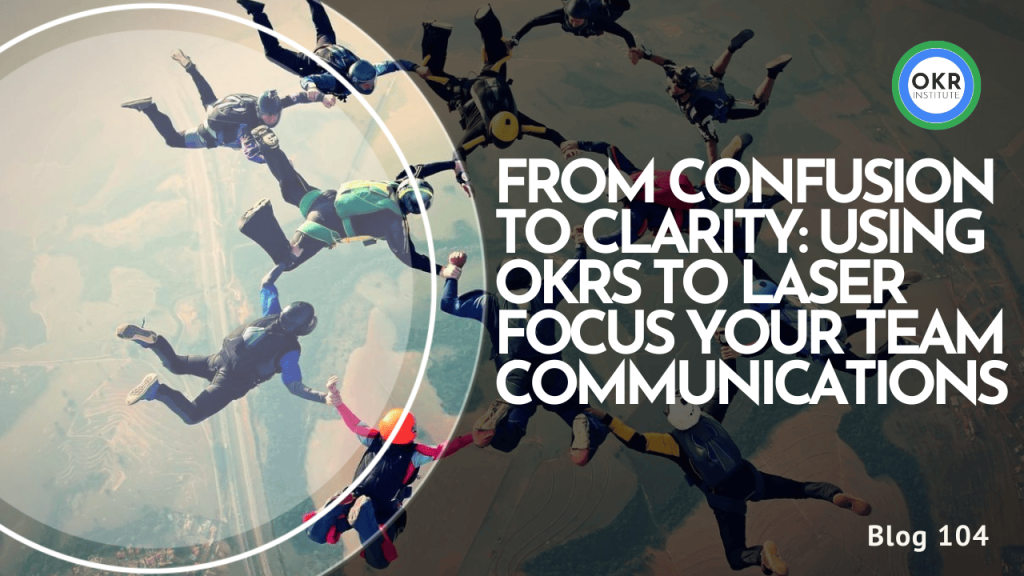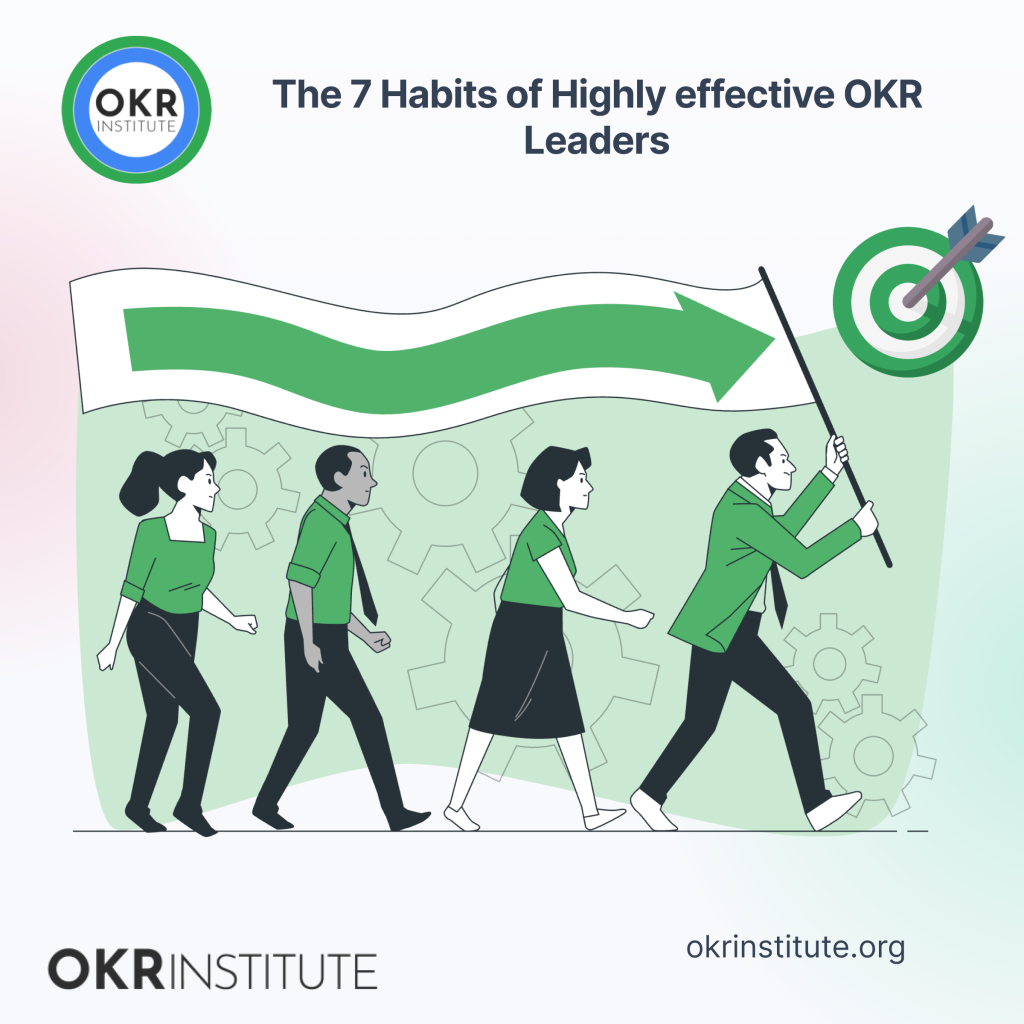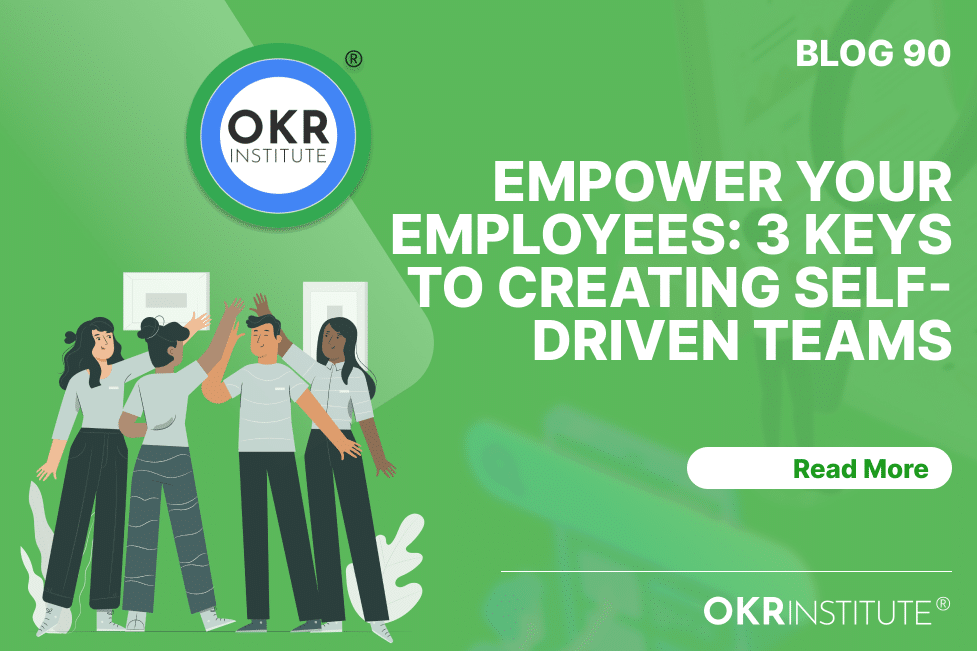From Confusion to Clarity: Using OKRs to Laser Focus Your Team Communications

Introduction
Effective communication is the lifeblood of any successful business team. It fosters collaboration, alignment, and productivity, enabling teams to achieve their goals efficiently. However, many teams face various communication challenges that can hinder their progress and overall performance. These challenges can range from lack of clarity and poor feedback mechanisms to information silos and ineffective meetings.
In today’s fast-paced business environment, where teams are often diverse and geographically dispersed, communication breakdowns can have far-reaching consequences. Miscommunications can lead to misunderstandings, delays, and even costly mistakes, ultimately impacting a company’s bottom line.
Fortunately, there is a powerful tool that can help address these communication issues: Objectives and Key Results (OKRs). By implementing OKRs, teams can establish clear objectives, align their efforts, and measure progress towards their goals. OKRs provide a structured framework for communication, ensuring that everyone is on the same page and working towards a common purpose.
Common Communication Issues in Business Teams
Business teams often face various communication challenges that can hinder their productivity and overall success. One major issue is the lack of clarity, where team members may not fully understand their roles, responsibilities, or the objectives of the projects they are working on, leading to confusion and inefficiencies.
Poor feedback mechanisms can also be a significant problem. Without effective feedback, team members may not know how well they are performing or where improvements are needed, leading to stagnation and frustration.
Information silos, where different departments or team members hoard information, can make it difficult for others to access crucial data, resulting in a lack of collaboration.
Ineffective meetings are another common challenge. Meetings can often be unproductive, with no clear agenda or follow-up actions, wasting time and resources.
In diverse teams, cultural and language barriers can lead to misunderstandings and miscommunications, further exacerbating communication issues.
Finally, the overload of information, with the constant flow of emails, messages, and notifications, can cause important information to get lost, and team members may feel overwhelmed, unable to prioritize effectively.
The Role of OKRs in Addressing Communication Challenges
OKRs (Objectives and Key Results) can serve as a powerful tool for addressing various communication challenges faced by business teams. By providing a clear framework for setting and tracking goals, OKRs help teams overcome common obstacles and foster a more collaborative and productive work environment.
Providing Clarity and Focus: One of the primary benefits of OKRs is their ability to bring clarity and focus to team objectives. By defining specific, measurable, and time-bound key results, OKRs ensure that every team member understands exactly what they are working towards and how their contributions align with the overall goals. This clarity eliminates confusion and helps team members prioritize their efforts effectively.
Improving Transparency and Collaboration: OKRs promote transparency by making team goals and progress visible to everyone involved. When OKRs are shared openly, team members can gain insights into each other’s responsibilities and workstreams, reducing information silos and encouraging collaboration. This increased transparency fosters a sense of accountability and enables teams to identify potential synergies or areas where they can support one another.
Facilitating Feedback and Performance Monitoring: Regular check-ins and reviews of OKRs create opportunities for feedback and performance monitoring. By tracking progress towards key results, team members can receive constructive feedback on their performance and identify areas for improvement. This ongoing feedback loop helps teams course-correct when necessary and ensures that everyone is aligned and working towards the desired outcomes.
Enhancing Alignment and Strategic Focus: OKRs align individual goals with team and organizational objectives, ensuring that everyone is moving in the same direction. This alignment helps teams maintain a strategic focus and prevents them from getting sidetracked by less critical tasks or initiatives. By keeping the team’s efforts aligned with the broader organizational goals, OKRs foster a shared sense of purpose and direction.
Streamlining Meetings and Reducing Information Overload: With clear OKRs in place, team meetings can become more focused and productive. Instead of meandering discussions, meetings can revolve around progress updates, identifying obstacles, and planning the next steps towards achieving the key results. Additionally, OKRs help prioritize what is truly important, reducing the noise from less critical tasks and minimizing information overload.
By addressing these communication challenges, OKRs empower teams to work more efficiently, collaborate effectively, and achieve their goals in a transparent and aligned manner.
Providing Clarity and Focus with OKRs
One of the primary benefits of implementing OKRs (Objectives and Key Results) is the clarity and focus they provide to teams. By clearly defining the objectives and key results, OKRs ensure that every team member understands what they are working towards and how their individual efforts contribute to the overall goals.
Setting well-defined objectives is crucial for aligning the team’s efforts. Objectives should be ambitious yet achievable, challenging the team to stretch their capabilities while remaining realistic. They should be specific, measurable, and time-bound, providing a clear target for the team to work towards.
Key results, on the other hand, are the measurable outcomes that indicate progress towards achieving the objectives. They should be quantifiable and specific, allowing teams to track and monitor their progress objectively. By breaking down objectives into measurable key results, teams can stay focused on the most important priorities and avoid getting sidetracked by less critical tasks.
When team members understand their roles and how their work contributes to the larger objectives, they can better prioritize their efforts and make informed decisions. This clarity reduces confusion and ensures that everyone is working towards the same goals, fostering a sense of purpose and alignment within the team.
Moreover, OKRs provide a framework for regular check-ins and progress reviews. By regularly assessing their performance against the defined key results, teams can identify areas that require additional attention or resources, and make necessary adjustments to stay on track. This continuous feedback loop helps maintain focus and ensures that the team’s efforts remain aligned with the overarching objectives.
Improving Transparency and Collaboration with OKRs
One of the significant benefits of implementing OKRs is the increased transparency and collaboration they foster within teams. By setting and sharing OKRs openly, teams can break down information silos and encourage cross-departmental collaboration.
Sharing OKRs across the team and organization creates a culture of transparency. Everyone knows what others are working on, the objectives they are striving towards, and the key results they need to achieve. This level of visibility not only promotes accountability but also facilitates collaboration. Team members can identify opportunities to support each other, share knowledge, and leverage synergies.
Furthermore, OKRs help bridge the gap between different departments or teams that may have traditionally operated in silos. By aligning their OKRs with the broader organizational goals, teams can better understand how their work contributes to the overall success. This understanding encourages cross-functional collaboration and knowledge sharing, as teams realize the interconnectedness of their efforts.
To facilitate cross-departmental collaboration, organizations can leverage OKRs to conduct interdepartmental workshops or meetings. These sessions provide a platform for teams to share their OKRs, discuss challenges, and explore opportunities for collaboration. By bringing together diverse perspectives and expertise, teams can find innovative solutions and leverage each other’s strengths.
Moreover, OKRs can be integrated into collaboration tools and platforms, making them accessible and visible to all team members. This accessibility further breaks down information silos and promotes a culture of transparency and collaboration, where everyone is aware of the team’s objectives and can contribute to achieving the desired results.
Facilitating Feedback and Performance Monitoring with OKRs
One of the significant advantages of implementing OKRs is the ability to facilitate feedback and monitor performance effectively. Regular OKR reviews provide a structured framework for teams to assess their progress, identify areas for improvement, and make data-driven decisions.
OKRs encourage a culture of continuous feedback and learning. By setting measurable Key Results, teams can objectively evaluate their performance against predefined targets. This data-driven approach removes subjectivity and biases, allowing for more constructive and actionable feedback.
During OKR review sessions, teams can analyze their progress towards achieving the Key Results. If a particular Key Result is lagging, the team can dive deeper to understand the root causes and develop strategies to address the challenges. This iterative process fosters a mindset of continuous improvement and adaptability.
Moreover, OKRs enable teams to track their performance over time. By comparing current OKR achievements with previous cycles, teams can identify patterns, celebrate successes, and learn from past experiences. This longitudinal view provides valuable insights into the team’s growth and helps identify areas that require additional support or resources.
Regular OKR check-ins also create opportunities for peer feedback and coaching. Team members can share their experiences, offer suggestions, and learn from one another’s successes and challenges. This collaborative approach not only enhances individual and team performance but also fosters a culture of trust, accountability, and professional development.
By facilitating feedback and performance monitoring, OKRs empower teams to make data-driven decisions, adapt to changing circumstances, and continuously improve their processes and outcomes. This iterative cycle of goal-setting, execution, and review promotes a growth mindset and drives teams towards excellence.
Enhancing Alignment and Strategic Focus with OKRs
OKRs serve as a powerful tool for aligning individual goals with team and organizational objectives. By cascading OKRs from the top levels of the organization down to individual contributors, everyone’s efforts become synchronized and focused on achieving the overarching strategic goals.
At the organizational level, leadership sets high-level OKRs that define the company’s priorities and direction. These OKRs are then broken down into more specific and actionable objectives for different teams and departments. Team-level OKRs are derived from the organizational OKRs, ensuring that the team’s work directly contributes to the broader organizational goals.
Individual contributors, in turn, set their personal OKRs based on the team-level OKRs. This alignment ensures that each person’s efforts are directly tied to the team’s objectives and, ultimately, the organization’s strategic priorities. By working towards their individual OKRs, employees are simultaneously contributing to the success of the team and the organization as a whole.
This cascading approach to OKRs creates a clear line of sight between individual contributions and the organization’s strategic direction. It fosters a sense of purpose and motivation, as employees understand how their work fits into the bigger picture and impacts the overall success of the company.
Moreover, OKRs promote cross-functional collaboration by aligning teams with shared objectives. When teams have visibility into each other’s OKRs, they can identify areas of overlap and opportunities for collaboration. This alignment facilitates coordination and ensures that teams are working in harmony towards common goals, rather than operating in silos.
By enhancing alignment and strategic focus, OKRs help organizations maintain a cohesive and unified approach to achieving their objectives. Everyone, from top leadership to individual contributors, is working towards the same objectives, ensuring that efforts are concentrated and resources are optimized for maximum impact.
Streamlining Meetings and Reducing Information Overload with OKRs
One of the significant advantages of implementing OKRs is their ability to streamline meetings and reduce information overload within teams. By aligning the team’s efforts towards specific objectives and key results, meetings can become more focused and productive.
With clear OKRs in place, meeting agendas can revolve around tracking progress towards these objectives and key results. Instead of meandering discussions or ambiguous topics, meetings can concentrate on addressing specific challenges, identifying roadblocks, and planning the next steps to achieve the desired outcomes.
Furthermore, OKRs help teams prioritize what truly matters. By focusing on the key results that drive the most impact, teams can filter out unnecessary noise and distractions. This laser-like focus on what’s essential reduces the risk of information overload, where team members feel overwhelmed by a constant influx of emails, messages, and notifications.
OKRs act as a guiding force, ensuring that discussions and efforts are directed towards the most critical goals and initiatives. This clarity of purpose minimizes time wasted on tangential or low-priority tasks, allowing teams to allocate their resources more effectively towards achieving their objectives.
Moreover, OKRs provide a clear framework for measuring progress and success. During meetings, teams can objectively assess their performance against the established key results, identify areas for improvement, and make data-driven decisions. This quantitative approach fosters a culture of accountability and continuous improvement, further enhancing the productivity and effectiveness of meetings.
By leveraging OKRs, teams can transform meetings from time-consuming and unfocused gatherings into efficient and purposeful sessions. The structured approach of OKRs enables teams to stay on track, prioritize their efforts, and minimize the noise and distractions that often plague modern workplaces.
OKR Examples for Addressing Communication Issues
OKR for Improving Communication Clarity
Objective: Enhance communication clarity within the team.
Key Result 1: Implement a standardized project briefing document and achieve 100% usage by the team within the first quarter.
Key Result 2: Conduct monthly team meetings with a structured agenda and clear action items, resulting in a 90% meeting satisfaction rate in post-meeting surveys.
Key Result 3: Develop and distribute a weekly update newsletter covering key project milestones and updates, achieving a 75% open rate.
OKR for Breaking Down Information Silos
Objective: Foster a culture of information sharing and collaboration.
Key Result 1: Create a shared knowledge base and ensure 100% team member contribution of at least one article or document per quarter.
Key Result 2: Conduct cross-departmental workshops quarterly to share insights and best practices, with at least 80% attendance.
Key Result 3: Implement a team collaboration tool (e.g., Slack, Microsoft Teams) and achieve 90% active usage rate within three months.
Implementing OKRs for Effective Communication
Introducing OKRs to address communication challenges within a team requires a structured approach and commitment from all members. Here are some steps and best practices to successfully implement OKRs for effective communication:
- Educate and Train: Start by educating the team about OKRs, their purpose, and their benefits for communication. Conduct training sessions to ensure everyone understands the concept, methodology, and how to set and track OKRs effectively.
- Gain Buy-In: Involve the team in the process of implementing OKRs. Encourage open discussions, address concerns, and gather feedback. When team members feel ownership and understand the value, they are more likely to embrace the change.
- Define Team OKRs: Collaborate with the team to define the team’s OKRs. Ensure that the objectives align with the overall organizational goals and that the key results are specific, measurable, and time-bound.
- Cascade Individual OKRs: Once the team OKRs are set, work with each team member to define their individual OKRs that contribute to the team’s objectives. This alignment ensures everyone is working towards a common goal.
- Establish Regular Check-Ins: Schedule regular check-ins, such as weekly or bi-weekly meetings, to review progress towards OKRs. These check-ins provide opportunities for feedback, collaboration, and course correction if needed.
- Encourage Transparency: Foster a culture of transparency by sharing OKRs and progress updates openly with the team. This promotes accountability, collaboration, and a shared understanding of priorities.
- Celebrate Wins: Recognize and celebrate achievements, both big and small, related to OKRs. This positive reinforcement motivates the team and creates a sense of accomplishment.
- Continuously Improve: Regularly review and refine the OKR process based on feedback and lessons learned. Adapt and make adjustments as needed to ensure OKRs remain effective in addressing communication challenges.
- Lead by Example: Leadership should model the behavior they expect from the team. Actively participate in setting, tracking, and communicating OKRs, demonstrating their commitment to the process.
- Integrate with Existing Processes: Align OKRs with existing project management, performance management, and communication processes to ensure a seamless integration and avoid duplication of efforts.
By following these steps and best practices, teams can successfully implement OKRs and leverage their power to improve communication, increase transparency, foster collaboration, and drive better alignment towards shared goals.
Conclusion
Implementing OKRs can be a game-changer for business teams facing communication challenges. By providing clarity and focus, fostering transparency and collaboration, facilitating feedback and performance monitoring, enhancing alignment with strategic goals, and streamlining meetings while reducing information overload, OKRs address the root causes of many communication issues.
The key benefits of using OKRs to improve team communication and productivity include:
- Clear Objectives and Priorities: OKRs help teams define and communicate their objectives and key results, ensuring everyone understands the goals and their role in achieving them.
- Increased Transparency and Collaboration: By sharing OKRs across the team and organization, teams can break down information silos and encourage collaboration, as everyone is aware of what others are working on.
- Continuous Feedback and Improvement: Regular check-ins and reviews of OKRs provide opportunities for feedback, allowing team members to understand their performance and areas for improvement, fostering a culture of continuous learning and growth.
- Strategic Alignment: OKRs align individual and team goals with the overall organizational strategy, ensuring that everyone is working towards the same objectives and contributing to the success of the organization.
- Efficient Meetings and Communication: By focusing on OKRs, meetings become more structured and productive, reducing time wasted on unproductive discussions and allowing teams to prioritize and address the most critical issues.
- Reduced Information Overload: OKRs help teams prioritize and focus on the key results that matter most, reducing the noise and distractions caused by less critical tasks and information.
By addressing communication challenges head-on with the implementation of OKRs, business teams can unlock their full potential, improve productivity, and achieve greater success in their endeavors.
CEO of the OKR Institute
Related Courses
Recent Posts
Tags
#OKR
#OKR Implementation
#Team Communication







